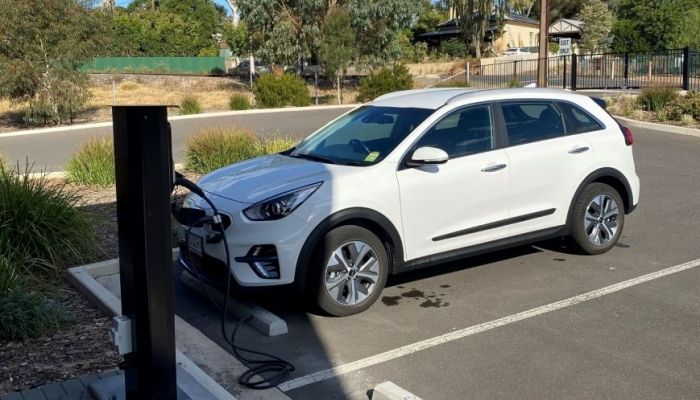Salvos trial first electric vehicle
3 June 2022

Words staff writers
In October last year, The Salvation Army procured its first electric vehicle (EV) to trial a transition to a renewable fleet. Partnering with AGL as part of their Innovation Fund, the Gawler Salvos in South Australia was provided with a charger with smart configuring capabilities that allows the Salvos to build data on charging times and work out the feasibility of 100 per cent renewable energy powering a vehicle for one of our Salvo officers (pastors).
HOW DOES IT WORK?
Devices are becoming increasingly intelligent; a vehicle charger can now talk to a metering device to see if the building is generating more solar than it is using and exporting the excess. If we can see when we are exporting solar, we can tell devices to automatically turn on to use some of this generated energy.
WHAT DOES IT COST?
EVs cost more upfront than internal combustion engines (ICE). So how can we see economic parity? With the cost of fuel sitting at record highs and the cost of self-produced electricity falling, there are financial and environmental benefits in using our excess solar production to power EVs.
For example, in a standard Kia Sportage, fuel consumption is seven litres per 100km. Therefore, travelling 450km costs around $53 at current average petrol prices of $1.70. In comparison, a Kia E-Niro EV charged using only solar excess costs only $4 for a full charge to travel 450km, or $16 if charged using the grid.
In short, EVs save money on fuel and maintenance and have a positive environmental impact – but it can take an extended period to pay back the upfront cost. Overall benefits begin to stack up in the long term and when the overall environmental impact is considered.
Q&A WITH MAJOR DARREN DWYER, GAWLER CORPS OFFICER
How has EV ownership changed the way you use your vehicle?
DD: Overall, there is not much significant change, just a bit of forward planning.
Did you have any concerns and, if so, how have these been overcome?
DD: We had concerns over charger network coverage and our ability to do longer journeys. However, we soon found that with a little planning, this was quite easily overcome. In fact, a month after having the car, I drove to Wagga Wagga from Gawler to conduct a wedding (a round trip of approximately 1850km) with no issues. As the charging points were all free, I did this entire trip with no fuel cost and no emissions.
Daytime charging is the most cost-effective way to charge the vehicle due to the substantial solar system at Gawler Salvos. Have you had any trouble managing this?
DD: Not at all. We have a simple system where an RFID tag unlocks the charger, then I plug the car in and leave it while I work in the office. It really couldn’t be simpler and cheaper.
Have you seen a positive social impact for yourself and for the Salvos?
DD: Yes, it has certainly opened some interesting conversations as people see the car and see the link to the Salvos. We think we are only one of three EVs in the town of Gawler, so we are being seen as very proactive and responsive to the climate crisis, which I definitely think the Church needs to be a frontline leader on.
I have also noticed a subtle admiration of The Salvation Army for being innovative, ahead of the curve, and willing to make some difficult decisions to accelerate social change and respond to a global social justice issue.
I have even had encounters head into spiritual territory as I have talked about our desire to be good stewards of creation and its finite resources. I strongly believe that there is a missional imperative in adopting an emission-free approach to our transport and power needs. If we want to reach the hearts and minds of the upcoming generations with the Gospel, we are going to have to demonstrate a clear and consistent message on how we are responding to climate change. Why would they listen to any organisation or individual who is not addressing the anxiety of the age?
Ask any young person what concerns them most, and I guarantee the vast majority will answer they are anxious and perplexed about the future of the climate and their own futures in a depleted environment. Adopting these simple and achievable measures gives us an obvious and credible way to say, “We understand, and we are doing something about it; we are not sitting on our hands hoping it all might go away.”
I believe you win the hearts of the younger generation through authentic action.

Comments
No comments yet - be the first.